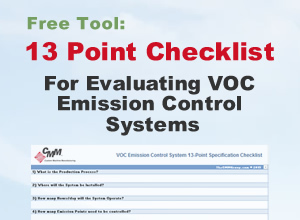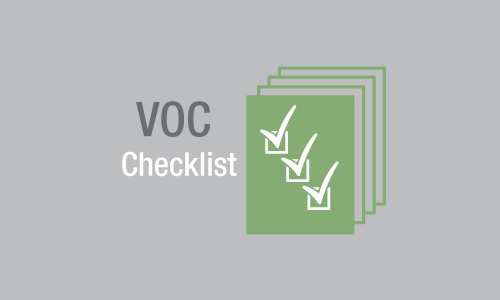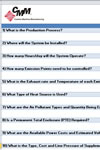 It’s no secret distinguishing the difference between one VOC control system manufacturer’s offerings and another can be challenging. Since product testing can’t be done prior to purchase, decisions are often made solely on a vendor’s credibility and design data.
It’s no secret distinguishing the difference between one VOC control system manufacturer’s offerings and another can be challenging. Since product testing can’t be done prior to purchase, decisions are often made solely on a vendor’s credibility and design data.
So how can you be certain the VOC emission control system you choose will not only meet your needs, but also provide years of trouble-free service long into the future?
The answer is not in asking the right questions, but providing the right information when submitting a formal RFQ (request for quotation) to VOC abatement system manufacturers.
Rather than submitting a general request for information, provide the vendor with thorough and precise operating and design criteria. Use the following specification checklist as a basis for preparing formal proposals to experienced vendors:
1) What is the Production Process?
Describe the production process emitting the air pollutant to be controlled. If possible, provide the vendor with a rough sketch of the building floor plan that indicates the location of all important production equipment.
2) Where will the System be Installed?
Since the outdoor climate (types of dampers/surface finishes, etc.) and the elevation level could have an effect on system design, provide the geographical location and elevation (fan sizing if known) where the system will be installed.
If possible, provide specific site installation plans that show details such as duct run and gas piping length as well as exhaust stack height. The actual location of the installation may require a steel support structure or concrete equipment pad.
3) How many Hours/Day will the System Operate?
Include an estimation of the number of hours per day that the system will operate. This is important because the chamber design, heat exchanger efficiency, etc. may change depending on the required operating hours.
4) How many Emission Points need to be controlled?
The total number of different emission points (exhaust stacks) may require a process control/bypass tee-damper at each emission point. The system’s electrical control design also changes depending on the number of dampers to be controlled.
5) What is the Exhaust rate and Temperature of each Emission Point?
Exhaust rates are important to note because they are taken into account when sizing the unit, ductwork and dampers. Temperature is used to calculate estimated operating costs and the necessity for ductwork insulation.
6) What Type of Heat Source is Used?
Describe the type of heat source used for any dryers or ovens that are to be controlled.
Gas-fired burners: The National Fire Protection Association (NFPA) regulations will determine the method of purging and damper control when the heat sources for process dryers/ovens are gas-fired burners.
Steam/Hot oil: Bypass tee-dampers/process control might not be required for each stack if heating by steam or hot oil.
7) What are the Air Pollutant Types and Quantity Being Emitted?
Be sure to list not only the air pollutant types, but also the quantity being emitted because the solvent type and quantity affect the
- Choice of catalyst used in catalyst units
- Heat exchanger efficiency
- Internal materials of construction
- VOC destruction efficiencies
- Estimated operating costs
8) Is a Permanent Total Enclosure (PTE) Required?
Make a determination as to whether the possible need for a PTE may be required. In many industries, the use of PTE’s have become very popular because of their ability to demonstrate high capture efficiency.
A properly designed permanent total enclosure will capture 100% of all air pollutants in the production area and for this reason, may be worth consideration. Depending upon the PTE design, the technology choice and sizing of a VOC destruction system may or may not be affected.
9) What are the Available Power Costs and Estimated Voltage?
The type of electronics used in the VOC destruction system are based on the available voltage, while power costs are used to determine estimated operating costs.
10) What is the Type, Cost and Line Pressure of Supplemental Fuel?
Fuel type (natural gas, propane, etc.) and line pressure: Fuel type and line pressure determine the fuel train design and burner.Fuel costs: Fuel costs are used to calculate estimated operating costs. Depending on the design of the VOC control system, compressed air might also be required.
11) What Percentage of Pollutant Destruction Efficiency is Required?
In catalytic models, the amount of catalyst needed is based on:
A) The required destruction efficiency percentage
B) The operating temperature and residence time in the type of technology that best suits your needs.
12) What Poisoning or Catalyst Masking Agents are Potentially Present in the Air Stream?
Catalyst masking or poisoning agents should be identified in advance to ensure the VOC control system can handle various levels of these compounds. Compounds of particular concern might include silicones, phosphorus, halogen, heavy metals and sulfur, among others.
13) What Are Your Growth Expectations?
It’s important to plan ahead when selecting or sizing a VOC emission control system. Consider your facility’s growth expectations over the next 2-5 years. It is normally more cost effective to install a system designed to handle additional capacity now, than to install a second system in the future.
The Quickest Path to Years of Trouble-Free Operation?
Remember, the more thorough and detailed you can be in your operating and design criteria checklist, the more likely it is that your VOC destruction system will meet your specific needs, seamlessly integrate into the process, and provide many years of trouble-free operation.




